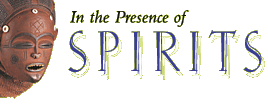



Also at the Smithsonian:
Worshiping the Ancestors at the Sackler Gallery looks at the spirits of China.
| In the Presence of Spirits is an exhibition of highlights from the African art collection of the Museu Nacional de Etnologia in Lisbon, Portugal. Although the Portuguese National Museum has organized and participated in several exhibitions of African art, no exhibition highlighting their African collection has ever traveled to the United States and very few of the objects in the museum’s collection have ever been on view outside of Europe.
As early as the 15th century, Portuguese explorers had set sail, seeking commercial expansion, the excitement of discovery and a population for Christian conversion. The Portuguese first traveled to central Africa in 1483, when Diogo Cão sailed into the mouth of the Congo River and established contact with the powerful Kongo Kingdom. Subsequently, other European nations began trading along the Atlantic seaboard. In addition to the commercial routes ferrying goods such as spices, gold, ivory and sugar, transatlantic slave trade routes were established by the mid-16th century. This exhibition examines an impressive group of over 140 objects that reflect the influences of the supernatural world in both public and private life throughout sub-Saharan Africa. The exhibition is organized according to both geography and the numerous cultural groups represented in the National Museum of Ethnology's collection. In the Presence of Spirits features objects that derive mainly, although not exclusively, from those areas where the Portuguese were present, such as Angola, Mozambique and Guinea-Bissau. A group of important artworks from western, central and southern Africa complements this selection. These artifacts demonstrate the rich variety and sculptural inventiveness of the cultures indigenous to these regions and provide insight into many of their spiritual practices. Highlights of the exhibition include figures, decorated stools and chairs, pipes, masks, staffs and dolls used by kings, queens, chiefs, priests, priestesses and diviners to summon spiritual forces. Major themes include an examination of prestige objects and power figures, initiation and funerary rituals, and symbols of spiritual and secular authority. The exhibition opens with a series of artworks from the Dan peoples of Côte d’Ivoire, the Baga from Guinea and the Fang from Equatorial Guinea. The next section contains power figures, symbols of authority, pictographic pot lids and funerary figures from various Kongo peoples. The largest section has initiation masks, figures, combs, pipes and chairs. These objects come from the Yaka, Nkanu, Zombo, Suku, Matapa and Chokwe-related peoples. The exhibition concludes with a spectacular ensemble of objects from the Bidjogo peoples who live on islands near the coast of Guinea-Bissau. In the Presence of Spirits brings together well-known, little-known and even unknown types of masks, figures and other sculpted objects from Africa. This exhibit once again reveals the many different faces of Africa’s artistic heritage, which never ceases to amaze and delight us.
In the Presence of Spirits: African Art from the National Museum of Ethnology, Lisbon, was organized by the Museum for African Art, New York, in cooperation with the National Museum of Ethnology, Portuguese Institute of Museums, Ministry of Culture, Lisbon, Portugal.
The exhibition has been made possible through the generous support of BP in Angola, with additional funding provided by the Instituto Português de Museus, Minestério da Cultura, Portugal, the Fundação Luso-Americana para o Desenvolvimento and the Fundação Calouste Gulbenkian. |